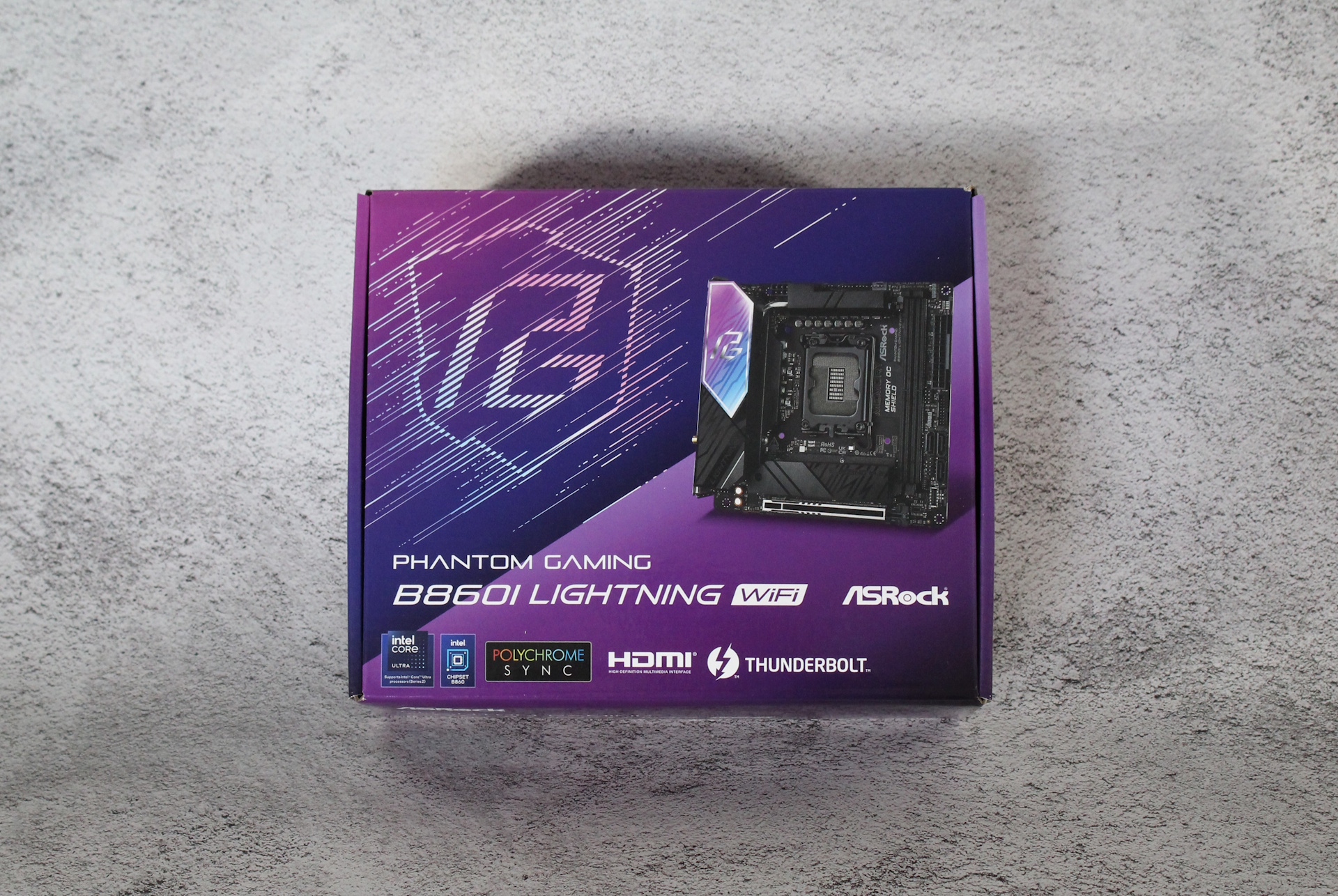Tom's Hardware Verdict
Priced well and packed with an attractive list of features, the B860I Lightning is a striking option in the budget Mini-ITX space, though its competitors offer more if you value Wi-Fi 7.
Pros
- +
Good looks
- +
Actively cooled VRMs
Cons
- -
‘Only’ Wi-Fi 6E
- -
Last-gen audio codec
Why you can trust Tom's Hardware
The latest mini motherboard is the ASRock B860I Lightning for Intel processors. This compact board provides an array of features, including robust power delivery with active cooling, a Thunderbolt 4 Type-C port, ample storage options with two M.2 sockets and three SATA ports, fast memory support, and an attractive design, all for around $220.
Compared to the B760I Lightning, the B860I looks better, and features a PCIe 5.0 M.2 socket, integrated Thunderbolt 4 (40 Gbps), an improved audio solution, and more. It shares the same LAN and Wi-Fi as the previous-gen model, but most users will be satisfied with 2.5 GbE and Wi-Fi 6E. Unlike AMD, which allows using last-generation chipsets with the latest processors, this update is a significant improvement.
Performance on the B860I Lighting was average across our tests, with some above-average results (Procyon/MS Office assessments), and some below-average outcomes (Handbrake tests). It performed well in gaming though, so overall, we’d consider it competent using the default settings.
Below, we’ll examine the board's details and determine whether it deserves a spot on our Best Motherboards list. But before we share test results and discuss details, we’ll list the specifications from ASRock’s website.
Specifications of the ASRock B860I Lightning Wifi
Socket | LGA 1851 |
Chipset | B860 |
Form Factor | Mini-ITX |
Voltage Regulator | 14 Phase (10x 110A SPS MOSFETs for Vcore) |
Video Ports | (1) HDMI 2.1 |
| Row 5 - Cell 0 | (1) Thunderbolt 4 (Type-C) |
USB Ports | (1) Thunderbolt 4 (40 Gbps) Type-C |
| Row 7 - Cell 0 | (2) USB 3.2 Gen 2 (10 Gbps) |
| Row 8 - Cell 0 | (4) USB 3.2 Gen 1 (5 Gbps) |
| Row 9 - Cell 0 | (1) USB 2.0 (480 Mbps) |
Network Jacks | (1) 2.5 GbE |
Audio Jacks | (2) Analog + SPDIF |
Legacy Ports/Jacks | ✗ |
Other Ports/Jack | ✗ |
PCIe x16 | (1) v5.0 (x16) |
| Row 15 - Cell 0 | Supports NVMe as boot disks |
PCIe x8 | ✗ |
PCIe x4 | ✗ |
PCIe x1 | ✗ |
CrossFire/SLI | ✗ |
DIMM Slots | (2) DDR5-933+(OC), 128GB Capacity |
M.2 Sockets | (1) PCIe 5.0 x4 (128 Gbps) / PCIe (up to 80mm) |
| Row 22 - Cell 0 | (1) PCIe 4.0 x4 (64 Gbps) / PCIe (up to 80mm) |
SATA Ports | (3) SATA3 6 Gbps |
| Row 24 - Cell 0 | (Supports RAID 0/1/5/10) |
USB Headers | (1) USB v3.2 Gen 2 (10 Gbps) Type-C |
| Row 26 - Cell 0 | (1) USB v3.2 Gen 1 (5 Gbps) |
| Row 27 - Cell 0 | (1) USB v2.0 (480 Mbps) |
Fan/Pump Headers | (3) 4-Pin (CPU, Chassis, AIO Pump) |
RGB Headers | (2) aRGB Gen 2 (3-pin) |
Diagnostics Panel | (1) POST Status Checker LEDs (4) |
Internal Button/Switch | ✗ |
SATA Controllers | ✗ |
Ethernet Controller(s) | (1) Realtek 8125BG (2.5 GbE) |
Wi-Fi / Bluetooth | Intel Wi-Fi 6E AX211 - 160 MHz, 6 GHz, BT 5.3 |
USB Controllers | ✗ |
HD Audio Codec | Realtek ALC1220 |
DDL/DTS | ✗ / ✗ |
Warranty | 1 Year |
Inside the Box of the ASRock B860I Lightning Wifi
Inside the box, aside from the motherboard, ASRock includes some accessories to help get you started. The list isn’t long, but you get two SATA cables, a Wi-Fi Antenna, screws for the M.2 sockets, and a thermistor cable to get you started.
Design of the B860I Lightning Wifi
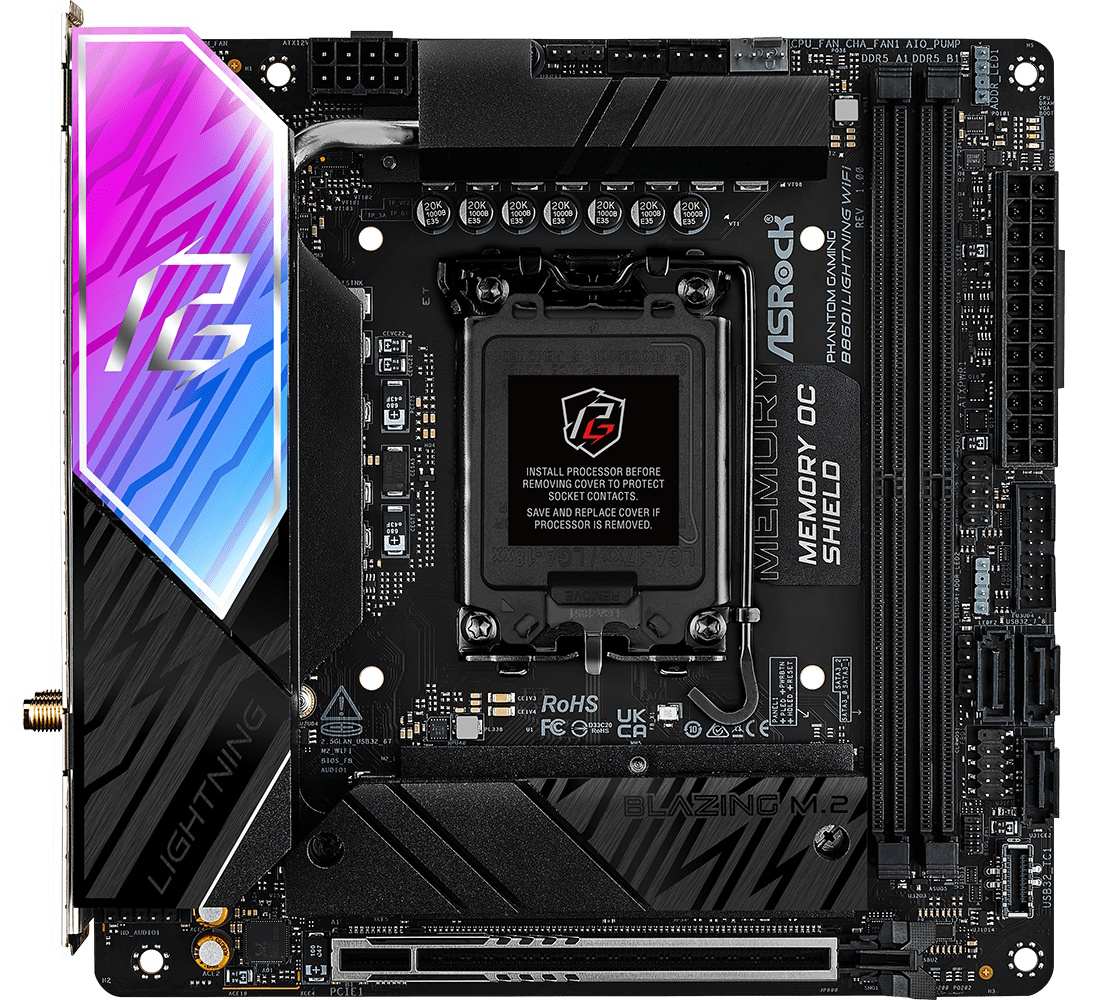
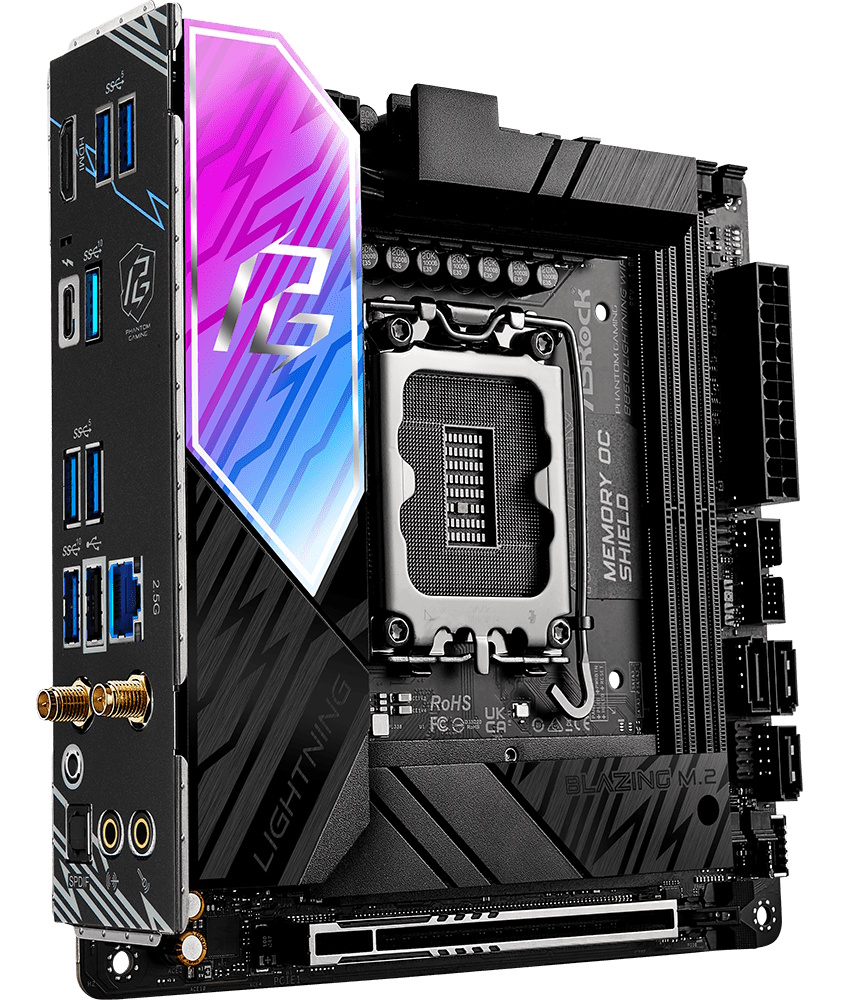

Unlike larger boards, the Mini-ITX form factor doesn’t have much space for design accouterments. In fact, the only areas are the VRM and chipset/M.2 heatsinks. ASRock uses the available space well, with the left heatsink sporting a lightning-like pattern on the primarily brushed aluminum finish. The top portion shows off the PG branding and that purple-to-blue color scheme. The PCB consists of 10 layers with a matte black finish on top. ASRock’s Polychrome Sync application controls any RGB lights attached to the headers.
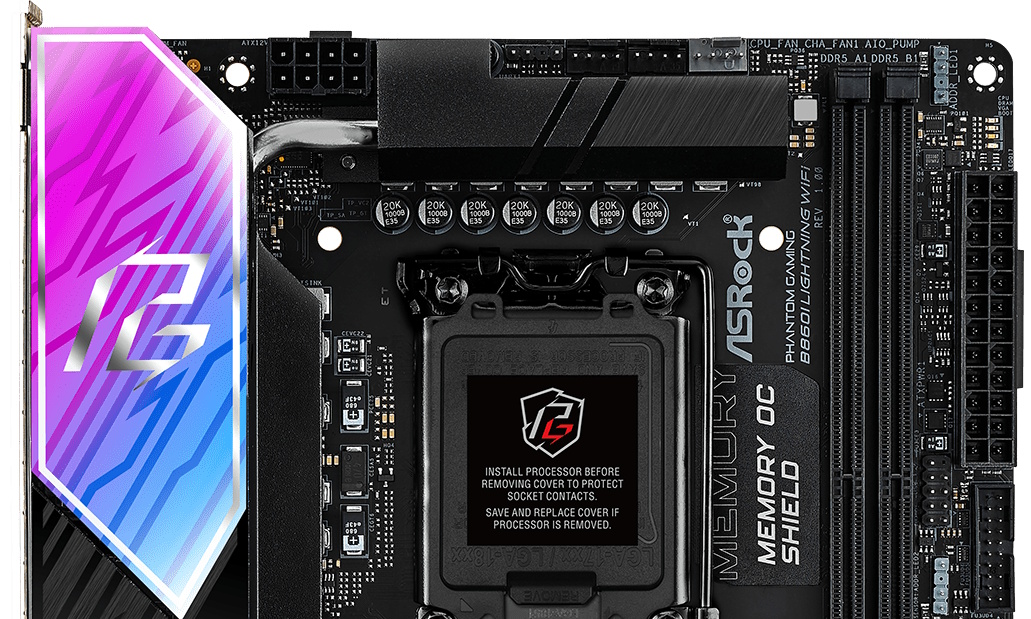
Our board tour starts on the left side, where we get a better look at the large heatpipe-connected VRM heatsinks. The neon purple and blue design feature on top stands out, giving the board a bit of extra style. Hidden underneath is a small fan to help with temperatures further. The fan was inaudible during most tasks but was audible during stress testing (expected) using the default fan curve. ASRock’s FAN-Tastic tuning inside the PG-Tune application controls the headers.
Get Tom's Hardware's best news and in-depth reviews, straight to your inbox.
Next to the top VRM heatsink is a single 8-pin connector to power the processor. Conveniently, all three 4-pin fan headers are above the heatsink in one area. The power output on the CPU and Chassis fan header is 1A/12W, and the AIO header can handle more at 3A/36W. ASRock’s PG-Tuning software and FAN-Tastic Tuning control the fans, as does the BIOS.
To the right are two DRAM slots equipped with ASRock’s Memory OC Shield, which aims to reduce electromagnetic interference, enhance signal integrity, and may improve stability and overclocking. Furthermore, they list support for DDR5-9333+(OC), which is impressive for this platform. We didn’t encounter any issues with our DDR5-8200 kits, but that’s to be expected at this stage, especially with CU-DIMMs. If you want to invest in fast RAM (you can’t overclock the CPU beyond the boost multiplier or BCLK), there’s ample headroom in the two-DIMM board.
The first of two 3-pin ARGB headers is in the upper-right corner. Along the right edge, you'll find the helpful Post Status Checker to assist with troubleshooting POST issues. Next is the 24-pin ATX power connector for the motherboard, along with two USB headers (2.0 and 19-pin 3.0 Gen 1), as well as the second 3-pin ARGB header. Most of the headers and connectors are situated in this area, which should facilitate cable management.
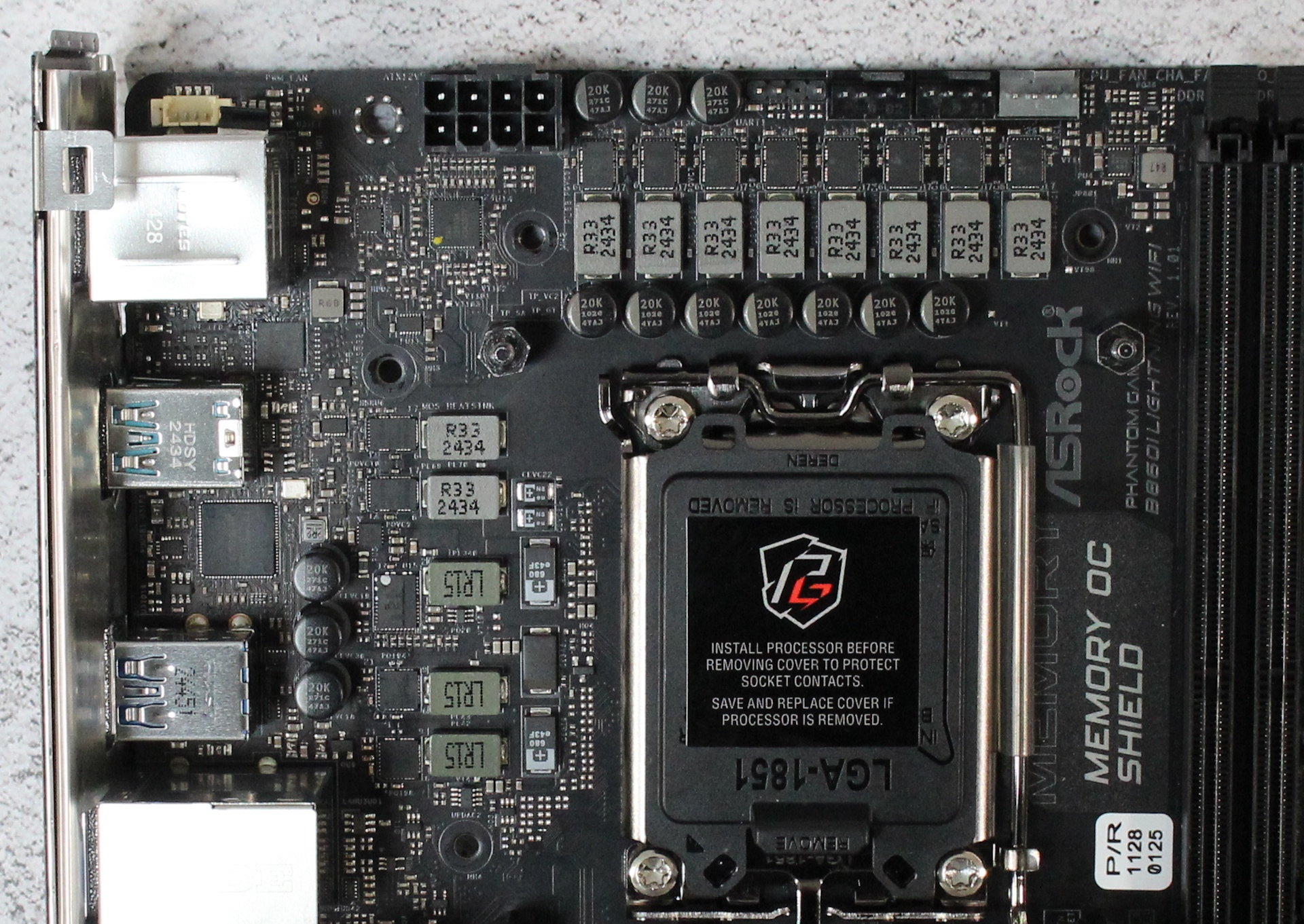
The B860I Lightning's power delivery system comprises 14 phases, with 10 dedicated to Vcore. Power flows from the 8-pin EPS into a Renesas RAA229134 controller. Subsequently, it reaches the 10 110A Renesas R2209004 SPS MOSFETs. The 1,100 Amps are sufficient to support our flagship Core Ultra 9 285K, and the active cooling system maintains optimal temperatures.

The three SATA ports (supporting RAID 0/1/5 modes) are located on the bottom-right edge, along with a 2-pin Clear CMOS jumper and a 2-pin header for the included thermistor. Below that is the front panel header, and the USB 3.2 Gen 2 (10 Gbps) front panel Type-C connector is positioned on the bottom edge.
At the bottom center, there’s a single full-length PCIe 5.0 x16 slot for your graphics card. If you don’t require a discrete graphics card and want more storage, you can install an M.2 expansion card and boot from it. Just above that, beneath a full-size heatsink, is the PCIe 5.0 x4 (128 Gbps) M.2 socket. You’ll find the second M.2 socket (which runs at 4.0 x4) on the back of the board.
Finally, the bottom left features all the audio components, including the previous generation flagship Realtek ALC1220 codec, dedicated audio capacitors, and the front-panel audio header. Audio control is managed by Nahimic 3 software, which offers a wide range of functionality.
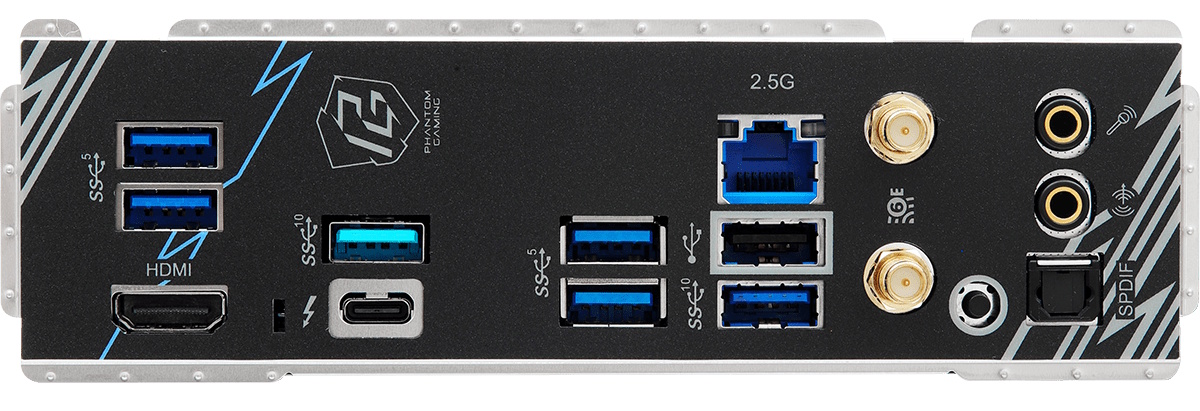
Flipping around to the rear IO, we see the seven USB Type-A ports staggered across the space, with the Thunderbolt 4 (40 Gbps) port located at the bottom. Next to it is the HDMI output for use with integrated graphics. On the right are the 2.5 GbE, standard WiFi 6E antenna connectors, the BIOS Flashback button, and finally, the two-plug (mic in/line out) plus SPDIF audio stack. Standard fare here, as well.
MORE: Best Motherboards
MORE: How To Choose A Motherboard
MORE: All Motherboard Content

Joe Shields is a staff writer at Tom’s Hardware. He reviews motherboards and PC components.
-
HideOut Although the audio codec on this board is not the most up-to-date, it's still far better than the 8xx codex the many more budget friendly boards use. It has thunderbolt 4 and 2.5 gig ethernet. It also seems to be pretty well built and it's built by a company that should still be here 6 months from now. This is probably one of the best budget-friendly itx boards we've seen in recent memory.Reply -
SonoraTechnical Reply
I agree.... ACS1200 is decent enough... Thunderbolt and 2.5 gig Ethernet are a surpise in a budget board too (though how budget is $200?) I'd would have liked to have seen 2x PCIe 5.0 nVME M.2 slots, but it don't think it's a show stopper for the 2nd HD in a system that is more long time file storage, rather than OS and Application launching. I'd have this direct wired, so the WiFi 6 would go unused anyway, so no issue that it's not the greatest WiFi 7 standard (my current stuff, modem, router, access point, don't even support Wifi 6 either).HideOut said:Although the audio codec on this board is not the most up-to-date, it's still far better than the 8xx codex the many more budget friendly boards use. It has thunderbolt 4 and 2.5 gig ethernet. It also seems to be pretty well built and it's built by a company that should still be here 6 months from now. This is probably one of the best budget-friendly itx boards we've seen in recent memory.
If I decide to go Ryzen R9 9950X3D and Radeon RX 9070XT on my Summer build as opposed to Ryzen AI MAX+ 395 w/ Radeonn 8060S iGPU , this might be a good board to purchase to offset some costs... -
LaminarFlow Last year I was trying to self-build a NAS and was torn between cheap Zen 3 (A520) vs Zen 4 (A620) ITX boards. Zen 3 ones tend to have 4 SATA ports but only Gb Ethernet, whereas Zen 4 ones come with 2.5GbE yet only 2 SATAs. Either way I have to use an adapter/PCI-E card of some sort. Eventually I went for A620 and a 8500G. It works but still leaves a bad taste in my mouth.Reply
This thing has 3 SATA ports...what kind of monstrosity is this?o_O -
thestryker I'd really like to see SATA ports dropped in the ITX format (honestly ditch them period) and replaced with SlimSAS ports because those can be dual use (SATA or NVMe). In the case of this board having just 2 SlimSAS ports would allow for one hybrid (4x SATA or 1x NVMe) and one NVMe giving more storage capability with less physical board space than the existing 3x SATA ports.Reply -
thestryker Reply
You're not going to see 2x (or more) PCIe 5.0 M.2 slots on the vast majority of ARL motherboards because the CPUs support 16x PCIe 5.0 lanes for slots, 4x PCIe 5.0 lanes for M.2, and 4x PCIe 4.0 lanes for M.2. That means the only way you're getting a second PCIe 5.0 M.2 is halving the lanes off the primary slot.SonoraTechnical said:I'd would have liked to have seen 2x PCIe 5.0 nVME M.2 slots, but it don't think it's a show stopper for the 2nd HD in a system that is more long time file storage, rather than OS and Application launching. -
SonoraTechnical Replythestryker said:You're not going to see 2x (or more) PCIe 5.0 M.2 slots on the vast majority of ARL motherboards because the CPUs support 16x PCIe 5.0 lanes for slots, 4x PCIe 5.0 lanes for M.2, and 4x PCIe 4.0 lanes for M.2. That means the only way you're getting a second PCIe 5.0 M.2 is halving the lanes off the primary slot.
Yeah, I know it's a limit with the current Ryzen architecture.... Threadripper would be different. LOL... Just speaking my mind.. Wish we had more PCIe 5.0 lanes available on the consumer grade CPUs.. -
thestryker Reply
Well AMD has enough lanes for 2x PCIe 5.0 x4 M.2 slots and some of the 600 series chipset boards have just that. When AMD mandated USB 4 support in the 800 series chipsets that took one of those away. Given that Intel has a PCIe 5.0/4.0 split on their CPU M.2 lanes now perhaps that'll change to 2x PCIe 5.0 x4 down the road.SonoraTechnical said:Yeah, I know it's a limit with the current Ryzen architecture.... Threadripper would be different. LOL... Just speaking my mind.. Wish we had more PCIe 5.0 lanes available on the consumer grade CPUs.. -
ocer9999 Honestly, Wi-Fi 6E is still plenty fast for most setups. Unless you're living in a Wi-Fi 7-enabled world, the B860i Lightning board offers a solid mix of features without breaking the bank.Reply
